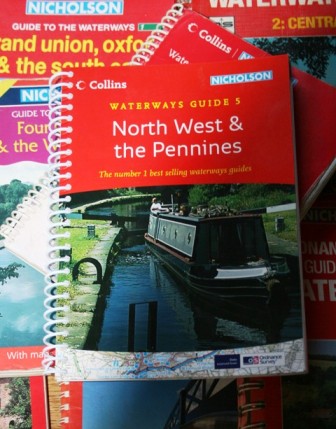
No 9: Nicholson Waterways Guides
What’s it about?
There are eight Nicholson Waterways Guides covering the many inland navigations to be found from the River Medway in the garden of England via the Montgomery Canal in deepest mid-Wales to the Caledonian Canal which thrusts north east through the Great Glen’s four lochs to link Fort William to Inverness. Dog-eared editions of the A5, ring-bound gazetteers can be found in wheelhouses and glory holes on craft from cruisers to narrowboats wherever waterways can be travelled by boat as no self-respecting skipper would venture out without one or other of the 40-year-old series. The books purport to assist the boat owner with details of lochs, bridges, boatyards, winding holes and water points. However, such is the wealth of detail about pubs, shops, churches, historical sites and garden centres and so beautifully are they rendered that any walker, cyclist or gongoozler (canalside on-looker) would do well to arm themselves with the relevant guide.
What’s it got to do with leisure?
So self-evident is the answer to this question we might do better to consider why such a utilitarian publication, or collection of publications, should be put forward as worthy of consuming a leisure manager’s leisure time. The answer lies in the whimsicality of the detail, the idiosyncrasy of the language, the beauty of the design and the profundity of the story each double page tells. Each navigation is split into sections and presented in a standard format: an Ordnance Survey map showing the waterway and some 500 yards of the land on either side, a paragraph of description, a bullet-pointed list of pubs and restaurants along the way and a second list of interesting or useful places in the vicinity. However, while the sections are almost always there, the detail varies wildly. With north at the top of the page and south at the bottom, an east-west canal runs from right to left over the two pages and if it loops in reality it loops on the map with the words having to find places to sit once the map is in place. Each descriptive introduction is a whimsical conundrum taking the reader on mellifluous flights of almost puritanically observed detail. Picked almost at random from guide number 5, the description of the Hardings Wood section of the Macclesfield Canal offers: “To the east Mow Cop crowns the ridge of tall hills that stretches parallel to the navigation for miles to come. You can take a good walk to the top on footpaths to the east of bridge 85. Beyond this point, the canal loses itself in splendid countryside for several miles as it approaches Congleton.” How can a cut-and-fill canal, which Thomas Telford imposed on the landscape like a latter-day wrecking ball, “lose itself”? Only in a Nicholson Guide.
Why should I read it?
Long before the X Factor, all good stories were about journeys (think Moses, the Canterbury Tales and The Lord of the Rings) and all good books took you on those journeys without you having to leave your leather-backed armchair by the fire. Nicholson’s Guides transport the reader in much the same way. As you sit, glass of port to hand, you can plan, recall or merely imagine your waterborne journey under pipe bridges, over aqueducts, past swing bridges and through locks and tunnels – some haunted, some not – knowing that when you choose your mooring your guide will take you to castles, museums or churches, villages and towns, theatres, synagogues or tourist information points, and reward you with a pub that “serves real ale, plus a range of specialist bottled beers, including many from Belgium” where snacks are available at weekends and dogs and well-behaved children are welcome.
the leisure manager’s library
An occasional series offering a guide to leisure-related literature
